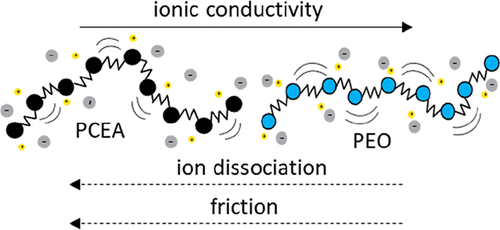当前位置:
X-MOL 学术
›
Macromolecules
›
论文详情
Our official English website, www.x-mol.net, welcomes your feedback! (Note: you will need to create a separate account there.)
Segmental Dynamics Measured by Quasi-Elastic Neutron Scattering and Ion Transport in Chemically Distinct Polymer Electrolytes
Macromolecules ( IF 5.5 ) Pub Date : 2020-03-31 , DOI: 10.1021/acs.macromol.0c00091 Katrina Irene S. Mongcopa 1 , Daniel A. Gribble 1 , Whitney S. Loo 1 , Madhusudan Tyagi 2, 3 , Scott A. Mullin 4 , Nitash P. Balsara 1, 5, 6
Macromolecules ( IF 5.5 ) Pub Date : 2020-03-31 , DOI: 10.1021/acs.macromol.0c00091 Katrina Irene S. Mongcopa 1 , Daniel A. Gribble 1 , Whitney S. Loo 1 , Madhusudan Tyagi 2, 3 , Scott A. Mullin 4 , Nitash P. Balsara 1, 5, 6
Affiliation

|
We investigate the segmental dynamics and ion transport in two chemically distinct polymer electrolytes, poly(2-cyanoethyl acrylate) (PCEA) and poly(ethylene oxide) (PEO), and their mixtures with lithium bis(trifluoromethane)sulfonimide (LiTFSI) salt. Quasi-elastic neutron scattering experiments reveal slow dynamics in PCEA/LiTFSI relative to that in PEO/LiTFSI, translating to monomeric friction coefficients that are orders of magnitude different. In spite of the enhanced salt dissociation in PCEA due to the presence of polar groups, ion transport is largely dominated by the effect of increased monomeric friction in the pure polymer. Conductivity in these systems is quantified through a simple expression combining salt dissociation, the monomeric friction in the pure polymer, and the effect of added salt on the monomeric friction.
中文翻译:

分段动力学的准弹性中子散射和离子迁移在化学上不同的聚合物电解质中的测量。
我们研究了两种化学上不同的聚合物电解质,聚(2-氰基丙烯酸乙酯)(PCEA)和聚(环氧乙烷)(PEO),以及它们与双(三氟甲烷)磺酰亚胺锂(LiTFSI)盐的混合物中的分段动力学和离子迁移。准弹性中子散射实验显示,相对于PEO / LiTFSI,PCEA / LiTFSI的动力学较慢,这意味着单体摩擦系数相差几个数量级。尽管由于极性基团的存在,PCEA中的盐离解作用增强,但离子传输仍主要受纯聚合物中单体摩擦力增加的影响。这些系统中的电导率通过简单的表达式进行量化,包括盐的解离,纯聚合物中的单体摩擦以及添加的盐对单体摩擦的影响。
更新日期:2020-04-24
中文翻译:

分段动力学的准弹性中子散射和离子迁移在化学上不同的聚合物电解质中的测量。
我们研究了两种化学上不同的聚合物电解质,聚(2-氰基丙烯酸乙酯)(PCEA)和聚(环氧乙烷)(PEO),以及它们与双(三氟甲烷)磺酰亚胺锂(LiTFSI)盐的混合物中的分段动力学和离子迁移。准弹性中子散射实验显示,相对于PEO / LiTFSI,PCEA / LiTFSI的动力学较慢,这意味着单体摩擦系数相差几个数量级。尽管由于极性基团的存在,PCEA中的盐离解作用增强,但离子传输仍主要受纯聚合物中单体摩擦力增加的影响。这些系统中的电导率通过简单的表达式进行量化,包括盐的解离,纯聚合物中的单体摩擦以及添加的盐对单体摩擦的影响。



























 京公网安备 11010802027423号
京公网安备 11010802027423号